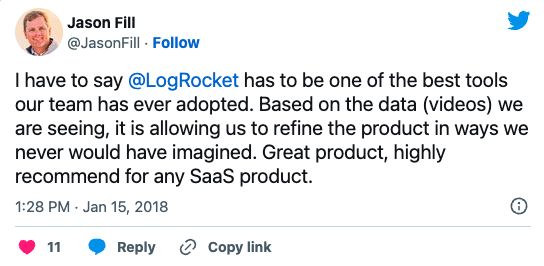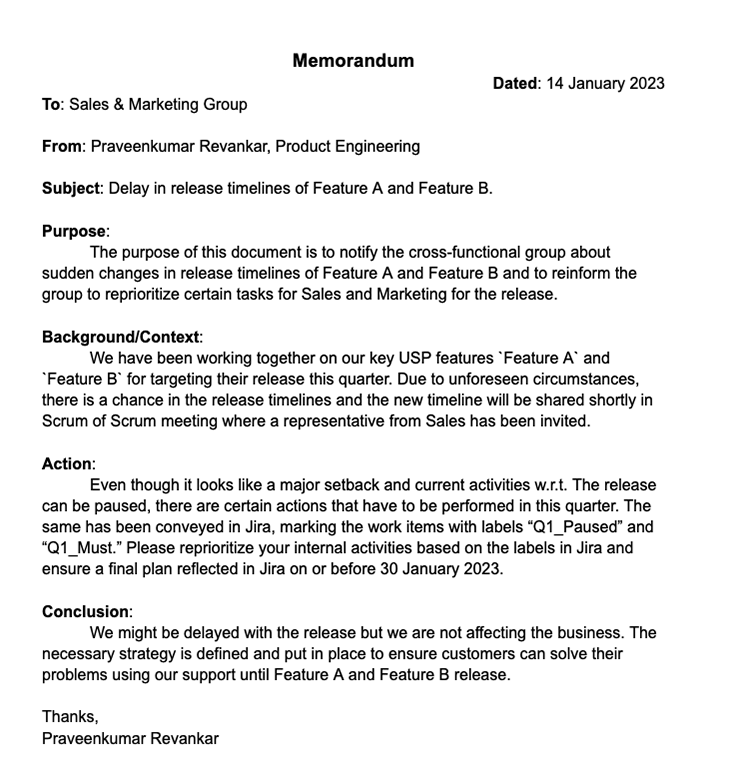How to write an effective memo: Format with examples
In the realm of workplace communication, the avenues are numerous. When reaching out to colleagues, superiors, or a group, choices abound. A call, a letter, an email, or a text; the options are diverse. From Skype to Slack, WhatsApp to sticky notes, the channels vary. Yet, all these methods align with either formal or informal communication.
Let’s delve into the formal realm, where precision is paramount. Emails, letters, official invites—all part of the formal toolkit. But, have you considered a communication relic from the 1800s? Enter the memo!
Memos, short for memorandums, have silently persisted through ages. Heard of them? Likely. But what exactly are they? When do you unfurl the memo magic, and what elements compose its essence? Here, we unravel the mysteries of memos, exploring their effectiveness as a potent instrument for formal communication. Let the journey begin.
What is a memo?
The term “memo” originates from the Latin word “memorandum,” translating to “that to be remembered.” In the realm of business, the need to convey crucial information internally is a common occurrence. Whether addressing your team, stakeholders, or specific customer groups, the imperative lies in delivering messages that leave a lasting impact. Similarly, crucial updates from HR, the finance team, executives, or the board of directors also fall under this category. These vital messages, regardless of urgency, collectively fall under the umbrella of memos.
Defining a Memo: A memo, in essence, is a concise and formal document designed for internal circulation. It serves the purpose of promptly bringing crucial information to the immediate attention of a specific group within the organization. Memos act as instruments to convey information that necessitates prompt acknowledgment and action.
Diverse Memo Content: A memo can encapsulate a spectrum of information vital for the internal audience to absorb and act upon. This could range from updates to operational processes, amendments to financial reimbursement policies, delays in project timelines, or the identification of unforeseen risks. The key objective is to ensure that the shared information is not only remembered but also prompts appropriate actions.
Distinct from External Documents: While legal contexts often involve Memorandums of Understanding (MOUs) or Memorandums of Agreement (MOAs), these are primarily external documents. In the business domain, memos predominantly serve the internal audience, acting as a vehicle for seamless communication within organizational groups.
Different types of memos
In the vast realm of organizational communication, the memo takes on diverse forms. A virtual stroll through online resources or a chat with seasoned leaders might introduce you to a variety of memo types, each with its distinct purpose:
1. Meeting Minutes or Summary Memos: Capturing the essence of discussions.
2. Reporting Memos: Unveiling crucial information and updates.
3. Incident or Root-Cause Memos: Investigating and addressing the core of issues.
4. Inquiry or Response Memos: Responding to queries or investigations.
5. Directives or Procedure Memos: Outlining instructions and processes.
6. Progress or Status Memos: Tracking and showcasing ongoing developments.
7. Warning or Notice Memos: Issuing alerts or formal notifications.
These categories, though self-explanatory, merely scratch the surface. Memo writing isn’t about rigid standards but rather an art form. No strict guidelines dictate your penmanship. Instead, it’s about discerning when to wield the memo and understanding its essential components. Let’s embark on a journey into the art of memo crafting.

When to write a memo
In the intricate dance of workplace communication, the memo takes the spotlight when:
1. Urgent Attention is Essential:
- When information demands immediate attention.
- When urgency signals the need for swift action.
2. Action is a Necessity:
- When available information requires a proactive response.
- When inertia must transform into decisive steps.
You may wonder, don’t we have the contemporary equivalents like “for your information” or “for immediate action” emails? Indeed, a nod to the digital era. However, the memo, with its formal touch, goes beyond mere information sharing. It steps into a space where urgency and action converge. Whether it’s meeting minutes or warning memos, each type finds its place in these scenarios.
So, the next time you contemplate crafting a memo, recall its core: a signal for urgent attention and a catalyst for decisive action.
Best Regards,
[Your Name] [Your Position]
What does a good memo have?
In the intricate choreography of workplace communication, the memo takes center stage when:
1. Urgent Attention is Essential:
- When information demands immediate attention.
- When urgency signals the need for swift action.
2. Action is a Necessity:
- When available information requires a proactive response.
- When inertia must transform into decisive steps.
You may wonder, don’t we have the contemporary equivalents like “for your information” or “for immediate action” emails? Indeed, a nod to the digital era. However, the memo, with its formal touch, goes beyond mere information sharing. It steps into a space where urgency and action converge. Whether it’s meeting minutes or warning memos, each type finds its place in these scenarios.
So, the next time you contemplate crafting a memo, recall its core: a signal for urgent attention and a catalyst for decisive action.
Best Regards,
[Your Name]
[Your Position]

Let’s look at them one by one:
Header
In the realm of hard copies on paper or PDF documents, the header stands prominently. However, in an email, its presence might be subtler. The header comprises the following key elements:
- Date: Indicates when the memo is sent or becomes effective, unless stated otherwise.
- To: Specifies the recipients, typically a group to whom the information or action applies.
- From: Identifies the sender, whether an individual, a well-defined group, or an entity.
- Subject: Offers a concise preview of the memo’s content, providing a quick overview.
Purpose/Introduction
True to its name, this section provides a concise preview of the memo’s content, serving as a powerful introduction. A well-crafted memo ensures this segment covers:
- A clear purpose of the communication.
- An objective that can translate into actionable steps.
Background/Context
Tailored to the memo’s nature, this section establishes the necessary background or context for understanding. While some memos skip this part, assuming familiarity within the team, a comprehensive memo always provides context before delving into details.
Actual Message
At the core of the memo lies the main message—the information or directive being conveyed to the audience. In the provided example, the message is seamlessly integrated into the background paragraph, emphasizing the paramount goal of ensuring the audience grasps the intent.
Action
This section outlines any actions the audience should take. Whether a call to action is present or not, a well-structured memo conveys it as a separate paragraph, ensuring clarity.
Wrapping It Up/Conclusion
Every memo benefits from a thoughtful conclusion for two primary reasons:
- To Summarize: Reinforces the key message, aiding retention and emphasizing crucial steps.
- To Lighten Up: Ensures the message is received appropriately, avoiding unnecessary panic or worry. The choice between a summary or a more reassuring conclusion depends on the memo’s nature.
In the provided example, a “cover” style conclusion is employed, offering a softer touch due to the less-than-positive nature of the shared news. The manner of conclusion may vary, but a well-crafted memo consistently concludes with the appropriate message for the audience.
Tips for writing a good memo
Crafting Effective Memos: A Personal Approach
In the realm of memo creation, one can utilize creativity, online templates, or Microsoft Office resources, striving for what one perceives as the best. However, what deems a memo “good” extends beyond personal satisfaction; it hinges on audience reception. While online tips advocate simplicity, focusing on the main point, and avoiding emotional language, I propose a personalized approach. My tried-and-true tips for crafting effective memos are as follows:
- Commence with Purpose: The cornerstone of a good memo lies in a clear, upfront declaration of purpose. This sets the stage, offering the reader a precise understanding of the memo’s intent.
- Subject Line Precision: Resist the temptation to delve into detailed subject lines. Instead, opt for a concise summary that entices the reader to open the communication. Lengthy subjects risk preemptive assumptions, potentially leading to oversight.
- Inclusive Conclusions: Regardless of context, never omit the conclusion. This section is pivotal, providing the reader with the significance of the memo’s content and its implications for them.
- Situational Awareness: Acknowledge the context in which you write the memo. Tailor your language to resonate appropriately with the addressed group, ensuring a reception aligned with the intended message.
- Brevity is Key: Memo storytelling need not span pages. Throughout my career, a single page sufficed. Aim for brevity, conveying the essential message and actions without unnecessary embellishments.
Additionally, adhere to fundamental guidelines:
- Audience Accuracy: Confirm you are addressing the correct audience.
- Date Precision: Ensure accurate dating, explicitly stating the effective date if applicable.
- Subject Line Inclusion: Never overlook the importance of a subject line.
- Anticipate Objections: Proactively address potential objections in your memo.
- Format Prowess: Present a clean and well-structured memo.
By intertwining these personal insights with fundamental memo etiquette, one can navigate the delicate balance of creativity, context, and clarity, ensuring a memo that not only satisfies the creator but resonates effectively with its intended audience.
Can you write just anything in a memo?
Memorandum of Appreciation (MOA)?
While the gesture was undoubtedly commendable, it underscored a common misconception: not every form of communication suits the memo format. Appreciations, requests, call-outs, vacation plans, and similar expressions fall more fittingly into the realms of emails or letters. Memos, by their nature, are reserved for disseminating information that necessitates action or retention by the audience.
The Memo’s Purpose: Action and Recall
A memo serves as a tool specifically designed for situations where the audience needs to absorb information and respond accordingly. It’s not a catch-all for every communication type. Understanding this distinction is crucial. When you wield a memo, it should be reserved for content that demands active engagement or long-term memory from the recipients.
In summary, don’t let the term “memo” become a catch-all. Instead, recognize its role as a targeted tool for conveying information that requires action or lasting recollection within a group setting.
When do product managers need memos?
For product managers pondering the significance of memos in their toolkit, the truth is evident—they are a vital communication asset. Across the spectrum of product management responsibilities, from updating stakeholders on project status to addressing risks, memos offer a structured and effective means of reaching diverse audiences, including administrative groups, executives, and customers.
Precision in Intent and Action
A memo’s strength lies not only in its content but also in its ability to convey intent with precision. This is especially critical for product managers, where clear communication is paramount. Well-crafted memos not only articulate the purpose of the communication but also provide a roadmap for the specific actions stakeholders need to take.
Adaptability Across Audiences
Navigating the varied landscape of product management involves communicating with audiences having distinct needs. Memos, with their adaptable format, prove to be a versatile tool. Whether addressing internal teams, executives, or customers, a meticulously structured memo ensures that the message aligns effectively with the intended audience.
Choosing the Memo Wisely
Effectively using memos in product management hinges on understanding when to deploy them. Memos shine brightest when dealing with complex scenarios that require both attention and action. They serve as a conduit for conveying information while prompting the necessary responses.
In essence, mastering the art of memo writing empowers product managers with a robust instrument to navigate the intricate challenges of communication in the dynamic realm of product development and management.
Conclusion
In conclusion, memo, elements such as a compelling title, a defined purpose, a contextual background, practical information, actionable steps, and a conclusive note converge to create a harmonious symphony of communication. It’s a reminder that memo writing transcends the mundane and ventures into the realm of artistry.
Let your memo be a testament to the art of conveying a message. Forge your narrative, not in the shadows of a template but in the radiant light of your unique situation. Memo writing, in its essence, is an art, waiting for your distinctive touch to bring it to life.





